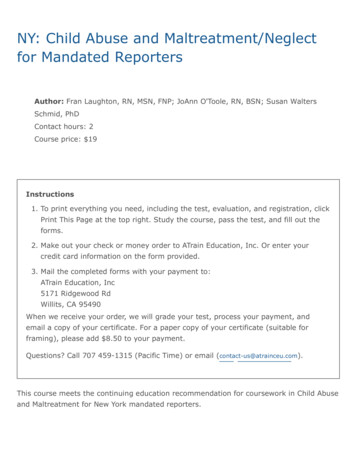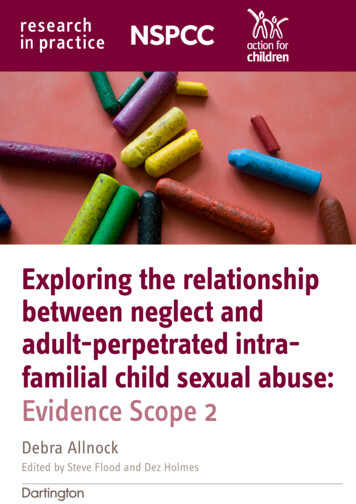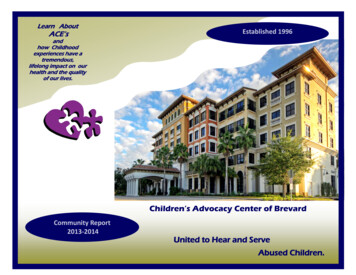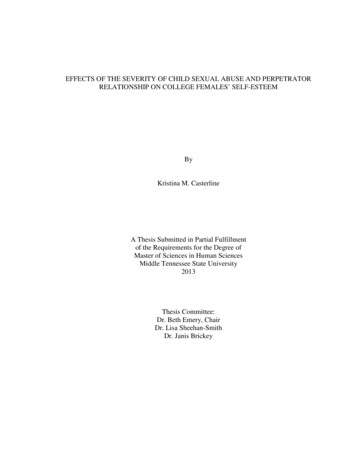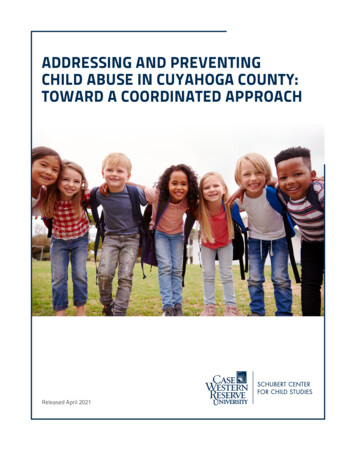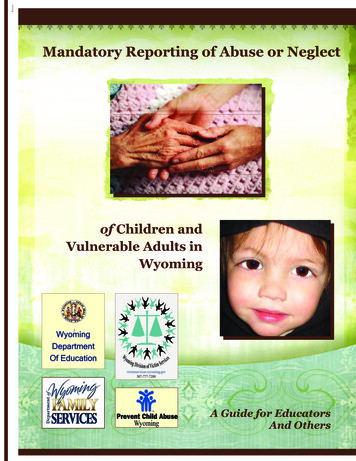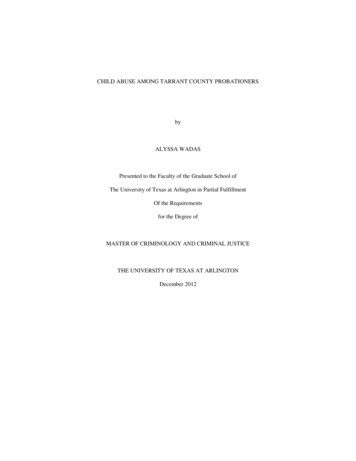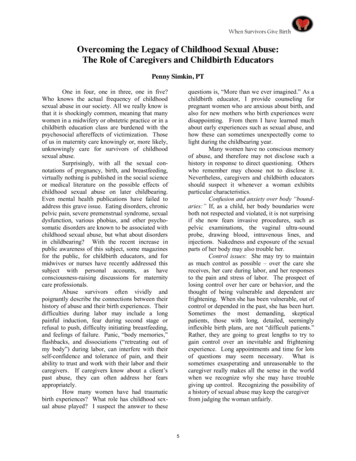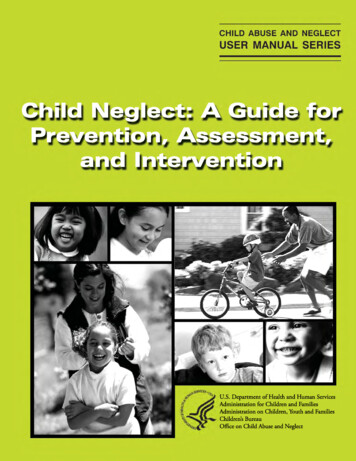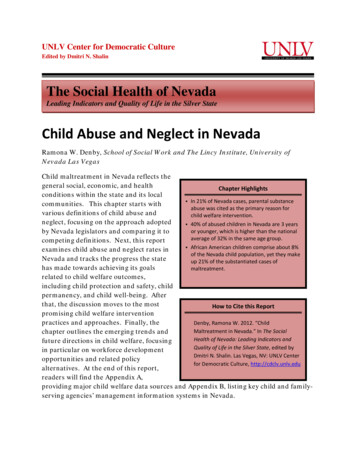
Transcription
UNLV Center for Democratic CultureEdited by Dmitri N. ShalinThe Social Health of NevadaLeading Indicators and Quality of Life in the Silver StateChild Abuse and Neglect in NevadaRamona W. Denby, School of Social Work and The Lincy Institute, University ofNevada Las VegasChild maltreatment in Nevada reflects thegeneral social, economic, and healthChapter Highlightsconditions within the state and its local In 21% of Nevada cases, parental substancecommunities. This chapter starts withabuse was cited as the primary reason forvarious definitions of child abuse andchild welfare intervention.neglect, focusing on the approach adopted 40% of abused children in Nevada are 3 yearsor younger, which is higher than the nationalby Nevada legislators and comparing it toaverage of 32% in the same age group.competing definitions. Next, this report African American children comprise about 8%examines child abuse and neglect rates inof the Nevada child population, yet they makeNevada and tracks the progress the stateup 21% of the substantiated cases ofhas made towards achieving its goalsmaltreatment.related to child welfare outcomes,including child protection and safety, childpermanency, and child well-being. Afterthat, the discussion moves to the mostHow to Cite this Reportpromising child welfare interventionpractices and approaches. Finally, theDenby, Ramona W. 2012. “ChildMaltreatment in Nevada.” In The Socialchapter outlines the emerging trends andHealth of Nevada: Leading Indicators andfuture directions in child welfare, focusingQuality of Life in the Silver State, edited byin particular on workforce developmentDmitri N. Shalin. Las Vegas, NV: UNLV Centeropportunities and related policyfor Democratic Culture, http://cdclv.unlv.edualternatives. At the end of this report,readers will find the Appendix A,providing major child welfare data sources and Appendix B, listing key child and familyserving agencies’ management information systems in Nevada.
1Nevada’s ChildrenBetween 2006 and 2009, the population of Nevada children under the age 18 hasranged from about 645,817 to 681,033. Reports of child maltreatment in this periodvacillated markedly. As table 1 shows, reports of maltreatment were at a high of 51children per 1000 in 2007 but fell to 37 per 1000 in 2009. When it comes tosubstantiated child maltreatment cases, Nevada’s rates declined from 8.3 per 1000children in 2006 to 6.9 per 1000 in 2009.Table 1. Nevada: Child Population Data and Prevalence of Child Abuse and Neglect (2006–2009)Year2006200720082009Total Children 18645,817667,521676,837681,033Children subject altreatmentreports30,47534,03929,76025,19247.2 per10005,3458.3 per100051.0 per10005,4178.1 per100044.0 per10004,8777.2 per100037.0 per10004,7086.9 per1000Data Sources: U.S. Census Bureau, 2010, as cited in U.S. DHHS, 2010b; ,NCANDS 2011, as cited in U.S. DHHS, 2010b.Child Maltreatment: What It Is and Why It IsTerms and DefinitionsChild maltreatment can be defined from multiple perspectives reflecting differentassumptions and legal parameters that are framed by federal legislation and statestatutes. Crosson-Tower (2002) pinpoints three major schools of thought in this area:(1) penal-legal, (2) medical-scientific, and (3) social welfare-humanistic. The penal-legalframework equates maltreatment with cruelty. The medical-scientific approach viewsmaltreatment from the lens of the battered-baby syndrome. And the social welfarehumanistic perspective sees the phenomenon as child abuse.Federal PerspectiveAll three theoretical perspectives tell us something important about child maltreatment,but it is federal and state law that provides the definitive reference point. Governmentconcern with child maltreatment is grounded in the legal concept parens patriae, whichasserts that the government has to take initiative in protecting children when theirparents fail or are unable to do so. Federal authority in this area is supported by nearly
2two dozen major child welfare laws enacted by the U.S. Congress (Curtis & Denby,2011). Federal law defines the minimal standards violation of which constitutes childmaltreatment. The 1974 Child Abuse Prevention and Treatment Act (CAPTA) P. L. 93247 (amended by the 2003 Keeping Children and Families Safe Act) defines child abuseand neglect as “any recent act or failure to act on the part of a parent or caretaker whichresults in death, serious physical or emotional harm, sexual abuse or exploitation; or anact or failure to act which presents an imminent risk of serious harm” (Child WelfareInformation Gateway, 2008, p. 2).Guided by federal law, most states recognize four types of child maltreatment: (1)physical abuse, (2) neglect, (3) sexual abuse, and (4) emotional abuse. According to theChild Welfare Information Gateway (2008), physical abuse is a nonaccidental physicalinjury that can occur as a result of punching, beating, kicking, biting, shaking, throwing,stabbing, choking, hitting, or burning that is inflicted by a parent or caregiver. Neglectis failure to provide for a child’s physical, medical, educational, and/or emotional needs.In most states, neglect also includes child abandonment and elements of substanceabuse, including prenatal exposure to illegal drugs and other substances. Child neglectcaused by substance abuse covers manufacturing drugs in the presence of a child;selling, distributing, or giving drugs and/or alcohol to a child; and the use of a substanceby a caregiver that impairs the caregiver and limits his or her ability to care for the child.Federal law defines child sexual abuse as “the employment, use, persuasion,inducement, enticement, or coercion of any child to engage in, or assist any other personto engage in, any sexually explicit conduct or simulation of such conduct for the purposeof producing a visual depiction of such conduct; or the rape, and in cases of caretaker orinter-familial relationships, statutory rape, molestation, prostitution, or other form ofsexual exploitation of children, or incest with children” (Child Welfare InformationGateway, 2008, p. 3). Emotional abuse (also referred to as psychological abuse) is apattern of behavior on the part of a parent or caregiver that results in a child’sdiminished sense of self-worth. Emotional abuse is difficult to prove; it typicallyaccompanies other forms of abuse and is evident in criticism, threats, and rejection.Nevada State StatuteAccording to Nevada statute, child maltreatment is a condition or set of interrelatedconditions that involve physical abuse, sexual abuse, socio-emotional abuse, and/orvarious parameters of neglect. Child maltreatment is an act of omission or commissionon the part of a parent of caregiver that results in physical, cognitive, emotional, orsocial harm to a child. Nevada’s definition of child abuse and neglect encompasses threecategories: (1) physical or mental injury of a nonaccidental nature, (2) sexual abuse orsexual exploitation, or (3) negligent treatment or maltreatment of a child caused orallowed by a person responsible for the welfare of the child under circumstancesindicating that the child’s health or welfare is harmed or threatened with harm (Chapter432B, 2011). Moreover, in Nevada, definitions of maltreatment are operationalizedthrough a risk assessment process that is framed by the Nevada Administrative Code(NAC) 432B.180 and differentiated by levels of urgency. According to the NAC,impending danger to a child results from a family situation or a household member’sbehavior that is determined to be out of control and will likely result in serious harm to achild (this was previously known as “foreseeable danger”). Present danger is an
3immediate, significant, and clearly observable family condition that is actively occurringor in process of occurring at the point of contact with a family and will likely result ingrievous harm to a child.Correlates of Child MaltreatmentGiven the serious nature of child abuse and neglect and its adverse consequences, manyhave asked, “What causes child abuse and neglect?” Although there have been nofindings that indisputably draw a cause-and-effect relationship, several conditions arebelieved to induce child maltreatment. Poverty, substance abuse, and parental mentalhealth disorders are three of these conditions.Poverty and Economic ConditionsAs an environmental factor, poverty and low-income status are highly correlated withchild maltreatment, especially child neglect. It is important to note that poverty doesnot automatically cause child neglect – a majority of families living in poverty are fullyfunctional, possess many strengths, including a host of protective factors that guardagainst child maltreatment. Yet poverty is implicated in child maltreatment insofar as itputs a family at a greater risk, especially when poverty is compounded by otherenvironmental risks such as parent’s age, substance abuse, parental capacity andreadiness. It has been proven that the level of child well-being in any given state isassociated with the state’s child poverty rate (DePanfilis, 2006; Slack, Holl, McDaniel,Yoo, & Bolger, 2004). In Nevada the poverty rate for children under the age of 18 isnearly 18%, 17% for children aged 5–17, and 20% for children under age 5 (ChildWelfare League of America, 2011). These rates are commensurate with national childpoverty rates. Thus, in 2009 the poverty rate for children under the age of 18 was 20%(U. S. Census Bureau, 2009).Substance AbuseParental substance abuse is another condition highly correlated with child maltreatment(Goldman & Salus, 2003; Kelley, 2002). In fact, child neglect has the strongestassociation with substance abuse as compared with all forms of child maltreatment(DePanfilis, 2006). One study found that 65% of maltreated children were victimizedwhile the parent was intoxicated (Donahue, 2004). Tragically, substance abuse isassociated with two thirds of child maltreatment fatalities (Kelley, 2002). Impairedparents are unable to function fully in the care and protection of their children, oftenplacing children in unsupervised conditions. Parents’ decision-making ability isimpaired when they are under the influence; their judgment becomes compromised astheir focus is narrowed by the addiction. Older children can be “parentified” or pressedto be parent surrogates and serve as caregivers for their younger siblings. In Nevada,approximately 5% of adults age 26 and older are reported to be dependent on or abusingillicit drugs (Substance Abuse and Mental Health Services Administration, Office ofApplied Studies, 2010). The Nevada law directs responsible authorities to notify agovernment agency about infants exposed to substances. Here is how Nevada RevisedStatute § 432B.220 (3) defines the issue:
4Any person who is a mandated reporter who delivers or provides medicalservices to a newborn infant and who, in his or her professional oroccupational capacity, knows or has reasonable cause to believe that thenewborn infant has been affected by prenatal illegal substance abuse or haswithdrawal symptoms resulting from prenatal drug exposure shall, as soonas reasonably practicable but not later than 24 hours after the person knowsor has reasonable cause to believe that the newborn infant is so affected orhas such symptoms, notify an agency that provides child welfare services ofthe condition of the infant and refer each person who is responsible for thewelfare of the infant to an agency that provides child welfare services forappropriate counseling, training, or other services. A notification and referralto an agency that provides child welfare services shall not be construed torequire prosecution for any illegal action. (Child Welfare InformationGateway, 2009, p. 21).In Nevada the federal Child and Family Services Review (CFSR) revealed that in 61% ofall child welfare cases, substance abuse was cited as a reason that the child came to theattention of the child welfare system. In 21% of the cases, parental substance abuse wascited as the primary reason for child welfare intervention (Young et al., 2004).Parental Mental HealthThe connection between parents’ mental health and child maltreatment is less definedthan the connection with poverty and substance abuse. However, certain mental healthconditions such as depression have been associated with child maltreatment anddiminished parenting abilities (Barth, 2009; Hoffman, Crnic & Baker, 2006; Jameson etal., 1997; Kahng et al., 2008; Shay & Knutson, 2008; U. S. Department of Health andHuman Services, 2003). Nevada ranks fifth in the nation of states considered to havethe highest number of depressed adults as determined by the number of depressiveepisodes and serious psychological distress (Mental Health America, 2011).Prevalence of Child Maltreatment in NevadaPrevalence and Types of Maltreatment and Demographic DataIn Nevada, as nationally, child neglect is the most frequently occurring type of childmaltreatment. In 2009 more than 73% of child welfare cases involved some level ofneglect.Table 2. Types of Maltreatment–Nevada 2Physical Abuse3.75.64.9Sexual Abuse8.49.413.5Emotional Abuse200973.227.97.82.9Data Sources: NCANDS, 2011, as cited in U.S. DHHS, 2010*Categories do not sum to 100% because of co-occurring conditions.
5Although child maltreatment in Nevada closely adheres to both regional and nationalpatterns, there are some observable differences. For example, in 2009 about 28% ofNevada’s substantiated cases of child maltreatment had some element of physical abuse,compared to an 18% rate nationally.Table 3. Types of Maltreatment–National (%)Year2009Neglect80.7Physical Abuse17.8Sexual Abuse9.5Emotional Abuse7.6Unknown9.9Data sources: U.S. DHHS et al., 2010Table 4. Types of Maltreatment (%) – 7200976.910.66.916.2Table 5. Types of Maltreatment (%) 8.40.925.08.80.6Note: Data Sources for Tables 4 and 5:NCANDS, 2011 as cited in U.S. DHHS, 2010From a regional standpoint there are also observable similarities and differences in thetypes and prevalence of child maltreatment. For example, Nevada is most similar toCalifornia with respect to patterns of child neglect but more closely aligned to Arizonawith respect to physical neglect. However, when Nevada is compared with its easternneighbor (Utah), there are fewer similarities. For example, significantly more ofNevada’s child welfare cases involve neglect and physical abuse than Utah’s.
6Table 6. Types of Maltreatment (%) – 0919.812.216.547.8Data Sources: NCANDS, 2011 as cited in U.S. DHHS, 2010Children of Color and Other Special PopulationsSome children in the child welfare system are considered to have “special needs.”Although there is no federal definition of “special needs” and the term’s meaning variesfrom state to state, within the context of child welfare adoption, special needs childrencan include “children of color; those who are older; children with siblings; or those witha medical, physical, or emotional condition or disability that results in the need foradoption or medical assistance in order for them to be adopted” (Child Welfareinformation Gateway, 2010a, p. 2). In the realm of general child welfare practice,special needs children are often classified in such a manner because of thevulnerabilities they face, their disproportionate representation, and the difficulties theyexperience with respect to achieving permanency.Two special needs groups in particular, African American children and young children,have received a fair level of examination empirically in the literature. There issubstantial evidence establishing the fact that African American children’s conditionwithin the child welfare system is very precarious, and they are detrimentally affected bythe system (Curtis & Denby, 2011; Hill, 2001, 2006; Roberts, 2002; U.S. GAO, 2007).They are disproportionately represented at nearly every point in the child welfaresystem (including rates of entry into the foster care system); they have slow departurerates as well as a host of other well-documented adverse conditions of care (Hill, 2006;Roberts, 2002; U.S. GAO, 2007). In Nevada, African American children represent 21%of the substantiated cases of maltreatment yet they are only about 8% of the childpopulation.Table 7. Ethnicity/Race of Maltreatment Victims veHawaiian/OtherPacific IslanderAlaskaNative/AmericanIndianTwo or .06.5Data source: NCANDS, 2011, as cited in U.S. DHHS, 2010
7Racial disparity is also evident in child placement rates. As indicated in tables 8 and 9,about 4,800 children were residing in foster care in Nevada in 2009, with AfricanAmericans accounting for more than one quarter of them. Many states have developedstrategies for addressing racial disproportionality in child welfare. (For a review ofmajor initiatives at both the state and federal level, visit the Child Welfare InformationGateway and download the Addressing Racial Disproportionality in Child Welfarereport which is accessible through this link:http://www.childwelfare.gov/pubs/issue briefs/racial disproportionality/racial disproportionality.pdf).Table 8. Nevada Foster Care Data (2006–2009)Breakdown of Children in Foster CareYear2006200720082009# of children infoster care5,0585,0085,0214,808Average length ofstay (months)12.513.314.815.7Data Sources: U.S. DHHS, AFCARS, 2010Table 9. Ethnicity/Race of Children in Foster Care veHawaiian/OtherPacific IslanderAlaskaNative/AmericanIndianTwo or .47.3Data sources: U.S. DHHS, AFCARS, 2010Young children are an especially vulnerable group when it comes to child welfare. Fortypercent of the children who are maltreated in Nevada are 3 years or younger. This figureis higher than the national average of 32% of maltreated children in the comparable agegroup (NCANDS, 2011, cited in U. S. DHHS, 2010a).
8Table 3. Age of Maltreatment Victims (%)Year2006Children 118.0Children 1–3 years old22.0Children 4–7 years old24.0Children 8–11 years old17.7Children 12–18 years 118.1200915.824.223.815.920.4Data sources: NCANDS, 2011, as cited in U.S. DHHS, 2010Consequences of MaltreatmentThe consequences of child maltreatment can be grave, and they often vary, dependingon the age of the child victim and the type of abuse or neglect that has been suffered.Children suffering abuse and neglect manifest the effect differently depending on thepresence of protective factors and other safeguards buffering or mitigating the impact ofmaltreatment. Below is a brief summary of the effects of physical abuse, neglect, sexualabuse, and emotional abuse.Effects of Physical AbusePhysical abuse can impact a child’s physical wellbeing, his or her emotionaldevelopment, and social maturity. Older children who have been physically abused aresusceptible to depression and may show sadness and anxiety, while younger childrencan exhibit signs of neurological impairments and/or sensory or psychomotordifficulties (Urquiza & Winn, 1994). Physical abuse threatens healthy infant-childattachment (Aber et al., 1990; Ainsworth, 1980).Effects of NeglectNeglected children may suffer from consequences of malnutrition, tend to be fragile,and are prone to disease. Among the less obvious consequences of child neglect arepassivity, withdrawal, social isolation, depression, and impulsivity (Helfer, 1987). Thenormal development of neglected children is severely compromised; their motor,mental, language, and other developmental milestones lag behind those of normallydeveloping children.Effects of Sexual AbuseChildren who have been sexually abused can experience immediate and lifelongconsequences. Victims may suffer physically from tears and abrasions in the genitalarea; they can contract sexually transmitted diseases or develop enuresis or encopresis.Other conditions found among sexually abused include sleep disturbances, bedwetting,and somatic complaints (Urguiza & Winn, 1994). The psychological effect of sexualabuse can be seen in so-called “internalizing behaviors” (largely girls) or “externalizingbehaviors” (largely boys), the symptoms of which include aggression, delinquency,hyperactivity, and verbal explosiveness. The effects that children suffer emotionally as aresult of sexual abuse include distrust, hostility, low self-esteem, fear, and anxiety.
9Effects of Emotional AbuseEmotionally abused children share many of the symptoms characteristic of other formsof abuse, including physical reactions (e.g., sleep disturbance, somatic complaints) andemotional disturbances (e.g., self-destruction, depression, suicidal ideations) (CrossonTower, 2002). Psychological abuse is common in families where both children andadults are deprived of emotional fulfillment. This form of abuse breeds consequencesthat affect a child’s personality as he or she progresses into adolescence (O’Hagan,1993). Emotional abuse is not easy to decipher, and it tends to be less understoodcompared to other types of child maltreatment. And yet, its consequences can belifelong and profound.Achieving the Major Child Welfare OutcomesThe three major child welfare outcomes are (1) child safety, (2) permanency, (3) familyand child well-being. The 1994 amendments to the Social Security Act authorized theU.S. Department of Health and Human Services to review states to ensure that they arein compliance with federal regulations as set forth in Titles IV-B and IV-E. The U.S.Children’s Bureau, through a process known as the Child and Family Services Reviews(CFSRs), administers a system that assesses children served by child welfare agenciesand that helps states improve their children and family services (U. S. DHHS, Children’sBureau, 2011).The child welfare system in Nevada is organized into three jurisdictions. The first andlargest service jurisdiction is run by Clark County Department of Family Services(CCDFS). Located in Las Vegas, it provides child welfare services to all children andfamilies in Clark County and the southern part of the state. The second service areaencompasses Washoe County Department of Social Services (WCDSS). It is located inReno and provides coverage for children and families located in Washoe County and thenorthwestern part of the state. The third service jurisdiction (comprising rural regionaloffices) is run by the Division of Child and Family Services (DCFS) and provides childwelfare services to 15 counties. The 2009 statewide CFSR survey revealed that Nevadafell below the 90% performance indicator marker in the safety areas but exceededperformance in three of the permanency areas and one of the family and child wellbeing indicators (for a complete review of the CFSR results see the 2010 Nevada AnnualProgress and Service Report available athttp://www.dcfs.state.nv.us/Reports/2010/2010 APSR.pdf).In both the 2004 and 2009 statewide CFSR review of Nevada, the Service Array andResource Development category was found to be an “Area Needing Improvement” dueto service gaps. Although some gains have been made, there are still tremendousimprovements that can be made in developing an accessible, effective, and appropriateservice system in order to respond to the needs of child and families involved in thechild welfare system. (For a review of Nevada’s planning activities and servicedevelopment goals and objectives, see the Nevada Child and Family Services Plan(CFSP) SFY 2010-2014).
10Child Welfare InterventionsChild welfare professionals use various interventions to assist children and families andpromote child safety, child permanency, and family and child well-being. Among themany approaches, family engagement models that are family-centered and strengthsbased are recognized as leading best practices. A growing body of evidence (assummarized by the Child Welfare Information Gateway, 2010b) suggests that the mosteffective family engagement strategies include, but are not limited to, the followingcomponents:1. Frequent and substantive caseworker visits. Frequent, meaningful,and focused contact with families by caseworkers produces increased childsafety, improved family functioning, and timely establishment of permanency.2. Family group decision-making (FGDM). FGDM has come to signify thegeneral use of a process where families are empowered to engage moredirectly by joining forces with professionals and other vital support people inthe decision making process. This approach is also known as family groupconferences, family team conferences, family team meetings, and family unitymeeting.3. Motivational interviewing. Motivational interviewing is a counselingmethod designed to promote behavior change and has been found to beeffective with child welfare parents who are struggling with substance abuseissues.4. Collaborative strategies. This practice model supports the use ofstrength-based approaches to help families achieve case goals.5. Active and meaningful roles for families. This intervention approachcalls for active involvement of families, and it has proven effective in creatingstronger worker-client alliances.6. Father involvement. Historically, fathers have not been sought for activeand meaningful engagement in case planning. However, fatherhoodprograms are emerging as viable practical options.7. Family search and engagement. Diligent search programs provesuccessful in locating relatives who can serve as effective caregivers. Familysearch models also encourage other types of family interactions, includingsibling connections.8. Mediation. Mediation models rely on neutral parties to assist families andchild welfare agencies in setting up goals and plans that improve familyfunctioning.
119. Parent partner programs. These programs use peer mentors and parentadvocate groups to assist families in navigating child welfare service systems.10.Foster family-birth family meetings. Such gatherings help birth andfoster families plan reunification strategies. This model also allows for moreinformation sharing and support between the birth and foster families.11.Parent and youth involvement in agency councils and boards. Thisapproach encourages the meaningful involvement of youth and parents inguiding child welfare policy and practice development within localcommunities.For more intervention about strategies that counter child maltreatment refer to theChild Neglect: A Guide for Assessment, Prevention and Intervention glect/neglect.pdfFuture ConsiderationsThe Child and Family Services Improvement and Innovation Act of 2011 (P. L. 112-34) isthe reauthorization of the Stephanie Tubbs Jones Child Welfare Services Program andthe Promoting Safe and Stable Families (PSSF) Act (http://aaicama.org/cms/federaldocs/CRS PL 112 34.pdf). Among its many features, it requires child welfare agenciesto produce more positive outcomes by arranging regular visits between workers andfamilies.The new federal law presents an opportunity for Nevada to further examine caseworkand family engagement approaches. The Nevada child welfare workforce is committedto the needs of children and families. Our state workers are among the most educated,dedicated, and skilled professionals in the country. A well-developed, competent, andsupported child welfare workforce is vital to ensuring the safety, permanency, and wellbeing of children who are involved in the child welfare system. In Nevada, NRS432B.195, 432B.397 and NAC 432B.090 require the state to provide staff training anddevelopment opportunities. Nevada has implemented major changes to its trainingprotocols for new workers and existing staff (see the 2009 Nevada StatewideAssessment report for a summary of planning and initiatives, available ewideAssessment2009.pdf). Inaddition to training efforts, future policy directives supporting infrastructures arecentral to ensuring the child welfare goals of safety, permanency, and family and childwell-being.
12ReferencesAber, J. L., & et al. (1990). The effects of maltreatment on development during earlychildhood: Recent studies and their theoretical, clinical, and policy implications.In D. Cicchetti and V. Carlson (Eds.), Child maltreatment: Theory and researchon the causes and consequences of child abuse and neglect (pp. 579–619). NewYork, NY: Cambridge University.Ainsworth, M. D. S. (1980). Attachment and child abuse. In G. Gerber, C. J. Ross, & E.Zigler (Eds.), Child abused reconsidered: An agenda for action (pp. 218–234).New York, NY: Oxford University.Barth, R. P. (2009). Preventing child abuse and neglect with parent training: Evidenceand opportunities. Future of Children, 19(2), 95–118.Chapter 432B. (2011). Protection of children from abuse and neglect. Retrieved onlineJanuary 2, 2012, at BSec020Child Welfare Information Gateway. (2008). What is child abuse and neglect? FactSheet. Retrieved online January 2, 2012, iscan.cfmChild Welfare Information Gateway. (2009). Parental drug use as child abuse:Summary of state laws. Retrieved online January 2, 2012, atwww.childwelfare.gov/systemwide/laws policies/statutes/drugexposed.cfmChild Welfare Information Gateway. (2010a). Special needs adoption: What does itmean? Retrieved January 2, 2012, athttp://www.childwelfa
UNLV Center for Democratic Culture . Edited by Dmitri N. Shalin . Child Abuse and Neglect in Nevada. Ramona W. Denby, School of Social Work and The Lincy Institute, University of Nevada Las Vegas . Child maltreatment in Nevada reflects the general social, economic, and health conditions within the state and its local communities. This chapter .
